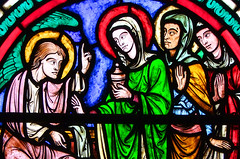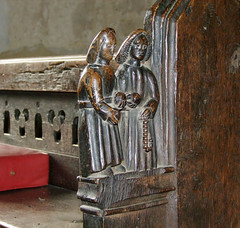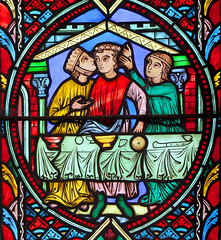| |
|
St Mary,
Feltwell
 |
|
Feltwell
is a fen edge village on rising ground, and as
such then the size of St Mary should come as no
surprise to us. Before the 17th Century, the
undrained fen spread westwards of here towards
Peterborough, and southwards towards Ely and
Cambridge, making transport of goods and people
much easier than going by land. The Ouse headed
up towards the Wash, as it still does of course,
and until the Fens were drained it was possible
for ocean-going ships to tie up at Feltwell.
This, then, was a prosperous port, and in common
with many other fen edge villages it has a church
to match. In fact, it has two churches, as there
is also St Nicholas, a pretty little thing about
half a mile off, and now in the care of the
Churches Conservation Trust. But if you were to
come to Feltwell for the first time, the
structures that would strike you as most
remarkable would probably not include the
churches. Three large communications domes rise
from RAF Feltwell, now part of the United States
Air Force's East Anglian operation. They look
like nothing so much as giant golf balls, and are
visible for miles. |
St Mary
seems tightly shoehorned into its long, narrow
churchyard, an effect accentuated by the wide north aisle
added by enthusiastic Victorians. The view from the south
is almost urban in its appearance, without the luxury of
a wide and ambling graveyard, and emphasises the sheer
size of the building. But the grandest touch of all is
south-west Norfolk's best tower. The sumptuous parapet
and pinnacles date right from the eve of the Reformation,
as probably does much of the nave, for a money-raising
campain of 1494 was used for a massive reconstruction
after a fire. The chancel is earlier, probably 14th
Century, and overall the effect of aisles and clerestory
beneath the great tower is a happy one.
The church
is open every day, and you step inside to a wide, open
interior, the smell of old wood and fresh-cut flowers,the
sight of dust falling silently in summer sunlight. The
benches to the west are almost entirely medieval, and if
the fire mentioned in 1494 affected the nave then they
are probably early 16th Century. The bench ends are
mostly vandalised, but the best represent the Works of
Mercy, including Feed the Hungry, Welcome the Stranger,
Bury the Dead and Visit the Prisoner.
   
Beyond the
rood screen, the chancel beckons, glowing and jewel-like.
You step through to find East Anglia's largest expanse of
19th Century French cathedral glass, both here and in the
19th Century south aisle which extends up to the east
wall of the chancel. It is by the Didron and Oudinot
workshops of Paris, and was installed in several
campaigns between 1859 and 1863. You wouldn't want every
church to have had this visited upon them, but here it is
magnificent. I like the Didron window telling the story
of the Prodigal Son best.
  
  
  
The size
of the chancel is accentuated by those great walls of
glass, and the floral altar frontal complements them
perfectly, although it must be said that the near-life
size figures of the Holy Family stepping down the chancel
steps are a little bizarre.
Stepping
out of the chancel again, you see there is a two-light
window beneath the tower by Didron depicting the story of
Adam and Eve. This is interesting, because the rest of
the glass in the nave is clear, but the French glass in
the chancel begins at the opening of the New Testament
and then heads east. Was there a plan to fill the nave
windows with Cathedral glass as well, telling the story
of the Old Testament? I'm glad they didn't, though it
would have been interesting to see.
| I
went into the wide open space of the 19th Century
north aisle, bigger than many churches on its
own. The architect was Frederick Preedy, who did
lots of work in this part of East Anglia, and it
was completed as part of the same scheme as the
glass, in 1863. Pevsner gives the cost of the
aisle as £1,500, about £300,000 in today's
money, which seems about right given that labour
was cheaper. The east end of the aisle
forms a war memorial chapel, and the rest is
given over to a kitchen and tables and chairs, a
sensible arrangement - a lovely medieval church,
with 21st Century amenities attached! But for all
the medieval glories of Feltwell, and for all its
21st Century life, it is the 19th Century which
shaped it and which leaves upon it its lasting
impression. As if to ensure this, memorials to
19th Century worthies punctuate the walls,
including that to Edward George Hibbert, late
Lieutenant Colonel of the Grenadier Guards.
Hibbert died in 1901,after having served
throughout the Crimean Campaign with the 50th
(Queen's Own) Regiment, and was present at the
Battles of Alma and Inkerman and the Siege and
Fall of Sevastapol.
|
|
 |
|
|
|


